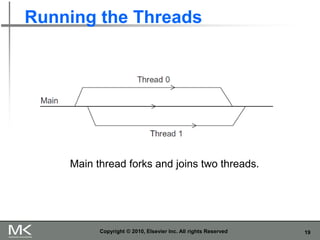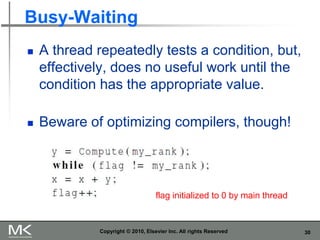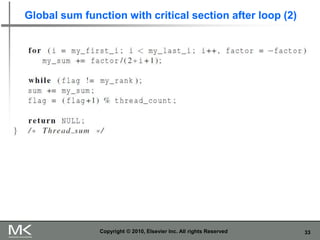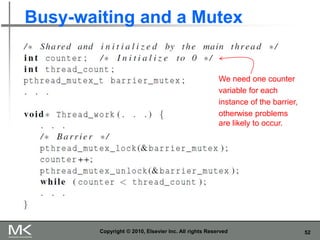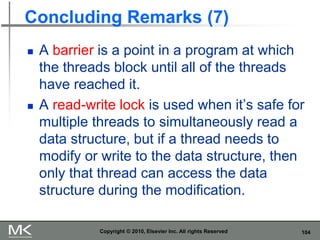Shared Memory Programming with Pthreads (1).ppt
- 1. 1 Copyright © 2010, Elsevier Inc. All rights Reserved Chapter 4 Shared Memory Programming with Pthreads An Introduction to Parallel Programming Peter Pacheco
- 2. 2 Copyright © 2010, Elsevier Inc. All rights Reserved Roadmap Problems programming shared memory systems. Controlling access to a critical section. Thread synchronization. Programming with POSIX threads. Mutexes. Producer-consumer synchronization and semaphores. Barriers and condition variables. Read-write locks. Thread safety. # Chapter Subtitle
- 3. 3 A Shared Memory System Copyright © 2010, Elsevier Inc. All rights Reserved
- 4. 4 Processes and Threads A process is an instance of a running (or suspended) program. Threads are analogous to a “light-weight” process. In a shared memory program a single process may have multiple threads of control. Copyright © 2010, Elsevier Inc. All rights Reserved
- 5. 5 POSIX®Threads Also known as Pthreads. A standard for Unix-like operating systems. A library that can be linked with C programs. Specifies an application programming interface (API) for multi-threaded programming. Copyright © 2010, Elsevier Inc. All rights Reserved
- 6. 6 Caveat The Pthreads API is only available on POSIXR systems — Linux, MacOS X, Solaris, HPUX, … Copyright © 2010, Elsevier Inc. All rights Reserved
- 7. 7 Hello World! (1) Copyright © 2010, Elsevier Inc. All rights Reserved declares the various Pthreads functions, constants, types, etc.
- 8. 8 Hello World! (2) Copyright © 2010, Elsevier Inc. All rights Reserved
- 9. 9 Hello World! (3) Copyright © 2010, Elsevier Inc. All rights Reserved
- 10. 10 Compiling a Pthread program Copyright © 2010, Elsevier Inc. All rights Reserved gcc −g −Wall −o pth_hello pth_hello . c −lpthread link in the Pthreads library
- 11. 11 Running a Pthreads program Copyright © 2010, Elsevier Inc. All rights Reserved . / pth_hello <number of threads> . / pth_hello 1 Hello from the main thread Hello from thread 0 of 1 . / pth_hello 4 Hello from the main thread Hello from thread 0 of 4 Hello from thread 1 of 4 Hello from thread 2 of 4 Hello from thread 3 of 4
- 12. 12 Global variables Can introduce subtle and confusing bugs! Limit use of global variables to situations in which they’re really needed. Shared variables. Copyright © 2010, Elsevier Inc. All rights Reserved
- 13. 13 Starting the Threads Processes in MPI are usually started by a script. In Pthreads the threads are started by the program executable. Copyright © 2010, Elsevier Inc. All rights Reserved
- 14. 14 Starting the Threads Copyright © 2010, Elsevier Inc. All rights Reserved pthread.h pthread_t int pthread_create ( pthread_t* thread_p /* out */ , const pthread_attr_t* attr_p /* in */ , void* (*start_routine ) ( void ) /* in */ , void* arg_p /* in */ ) ; One object for each thread.
- 15. 15 pthread_t objects Opaque The actual data that they store is system- specific. Their data members aren’t directly accessible to user code. However, the Pthreads standard guarantees that a pthread_t object does store enough information to uniquely identify the thread with which it’s associated. Copyright © 2010, Elsevier Inc. All rights Reserved
- 16. 16 A closer look (1) Copyright © 2010, Elsevier Inc. All rights Reserved int pthread_create ( pthread_t* thread_p /* out */ , const pthread_attr_t* attr_p /* in */ , void* (*start_routine ) ( void ) /* in */ , void* arg_p /* in */ ) ; We won’t be using, so we just pass NULL. Allocate before calling.
- 17. 17 A closer look (2) Copyright © 2010, Elsevier Inc. All rights Reserved int pthread_create ( pthread_t* thread_p /* out */ , const pthread_attr_t* attr_p /* in */ , void* (*start_routine ) ( void ) /* in */ , void* arg_p /* in */ ) ; The function that the thread is to run. Pointer to the argument that should be passed to the function start_routine.
- 18. 18 Function started by pthread_create Prototype: void* thread_function ( void* args_p ) ; Void* can be cast to any pointer type in C. So args_p can point to a list containing one or more values needed by thread_function. Similarly, the return value of thread_function can point to a list of one or more values. Copyright © 2010, Elsevier Inc. All rights Reserved
- 19. 19 Running the Threads Copyright © 2010, Elsevier Inc. All rights Reserved Main thread forks and joins two threads.
- 20. 20 Stopping the Threads We call the function pthread_join once for each thread. A single call to pthread_join will wait for the thread associated with the pthread_t object to complete. Copyright © 2010, Elsevier Inc. All rights Reserved
- 21. 21 MATRIX-VECTOR MULTIPLICATION IN PTHREADS Copyright © 2010, Elsevier Inc. All rights Reserved
- 22. 22 Serial pseudo-code Copyright © 2010, Elsevier Inc. All rights Reserved
- 23. 23 Using 3 Pthreads Copyright © 2010, Elsevier Inc. All rights Reserved thread 0 general case
- 24. 24 Pthreads matrix-vector multiplication Copyright © 2010, Elsevier Inc. All rights Reserved
- 25. 25 CRITICAL SECTIONS Copyright © 2010, Elsevier Inc. All rights Reserved
- 26. 26 Estimating π Copyright © 2010, Elsevier Inc. All rights Reserved
- 27. 27 Using a dual core processor Copyright © 2010, Elsevier Inc. All rights Reserved Note that as we increase n, the estimate with one thread gets better and better.
- 28. 28 A thread function for computing π Copyright © 2010, Elsevier Inc. All rights Reserved
- 29. 29 Possible race condition Copyright © 2010, Elsevier Inc. All rights Reserved
- 30. 30 Busy-Waiting A thread repeatedly tests a condition, but, effectively, does no useful work until the condition has the appropriate value. Beware of optimizing compilers, though! Copyright © 2010, Elsevier Inc. All rights Reserved flag initialized to 0 by main thread
- 31. 31 Pthreads global sum with busy-waiting Copyright © 2010, Elsevier Inc. All rights Reserved
- 32. 32 Global sum function with critical section after loop (1) Copyright © 2010, Elsevier Inc. All rights Reserved
- 33. 33 Global sum function with critical section after loop (2) Copyright © 2010, Elsevier Inc. All rights Reserved
- 34. 34 Mutexes A thread that is busy-waiting may continually use the CPU accomplishing nothing. Mutex (mutual exclusion) is a special type of variable that can be used to restrict access to a critical section to a single thread at a time. Copyright © 2010, Elsevier Inc. All rights Reserved
- 35. 35 Mutexes Used to guarantee that one thread “excludes” all other threads while it executes the critical section. The Pthreads standard includes a special type for mutexes: pthread_mutex_t. Copyright © 2010, Elsevier Inc. All rights Reserved
- 36. 36 Mutexes When a Pthreads program finishes using a mutex, it should call In order to gain access to a critical section a thread calls Copyright © 2010, Elsevier Inc. All rights Reserved
- 37. 37 Mutexes When a thread is finished executing the code in a critical section, it should call Copyright © 2010, Elsevier Inc. All rights Reserved
- 38. 38 Global sum function that uses a mutex (1) Copyright © 2010, Elsevier Inc. All rights Reserved
- 39. 39 Global sum function that uses a mutex (2) Copyright © 2010, Elsevier Inc. All rights Reserved
- 40. 40 Copyright © 2010, Elsevier Inc. All rights Reserved Run-times (in seconds) of π programs using n = 108 terms on a system with two four-core processors.
- 41. 41 Copyright © 2010, Elsevier Inc. All rights Reserved Possible sequence of events with busy-waiting and more threads than cores.
- 42. 42 PRODUCER-CONSUMER SYNCHRONIZATION AND SEMAPHORES Copyright © 2010, Elsevier Inc. All rights Reserved
- 43. 43 Issues Busy-waiting enforces the order threads access a critical section. Using mutexes, the order is left to chance and the system. There are applications where we need to control the order threads access the critical section. Copyright © 2010, Elsevier Inc. All rights Reserved
- 44. 44 Problems with a mutex solution Copyright © 2010, Elsevier Inc. All rights Reserved
- 45. 45 A first attempt at sending messages using pthreads Copyright © 2010, Elsevier Inc. All rights Reserved
- 46. 46 Syntax of the various semaphore functions Copyright © 2010, Elsevier Inc. All rights Reserved Semaphores are not part of Pthreads; you need to add this.
- 47. 47 BARRIERS AND CONDITION VARIABLES Copyright © 2010, Elsevier Inc. All rights Reserved
- 48. 48 Barriers Synchronizing the threads to make sure that they all are at the same point in a program is called a barrier. No thread can cross the barrier until all the threads have reached it. Copyright © 2010, Elsevier Inc. All rights Reserved
- 49. 49 Using barriers to time the slowest thread Copyright © 2010, Elsevier Inc. All rights Reserved
- 50. 50 Using barriers for debugging Copyright © 2010, Elsevier Inc. All rights Reserved
- 51. 51 Busy-waiting and a Mutex Implementing a barrier using busy-waiting and a mutex is straightforward. We use a shared counter protected by the mutex. When the counter indicates that every thread has entered the critical section, threads can leave the critical section. Copyright © 2010, Elsevier Inc. All rights Reserved
- 52. 52 Busy-waiting and a Mutex Copyright © 2010, Elsevier Inc. All rights Reserved We need one counter variable for each instance of the barrier, otherwise problems are likely to occur.
- 53. 53 Implementing a barrier with semaphores Copyright © 2010, Elsevier Inc. All rights Reserved
- 54. 54 Condition Variables A condition variable is a data object that allows a thread to suspend execution until a certain event or condition occurs. When the event or condition occurs another thread can signal the thread to “wake up.” A condition variable is always associated with a mutex. Copyright © 2010, Elsevier Inc. All rights Reserved
- 55. 55 Condition Variables Copyright © 2010, Elsevier Inc. All rights Reserved
- 56. 56 Implementing a barrier with condition variables Copyright © 2010, Elsevier Inc. All rights Reserved
- 57. 57 READ-WRITE LOCKS Copyright © 2010, Elsevier Inc. All rights Reserved
- 58. 58 Controlling access to a large, shared data structure Let’s look at an example. Suppose the shared data structure is a sorted linked list of ints, and the operations of interest are Member, Insert, and Delete. Copyright © 2010, Elsevier Inc. All rights Reserved
- 59. 59 Linked Lists Copyright © 2010, Elsevier Inc. All rights Reserved
- 60. 60 Linked List Membership Copyright © 2010, Elsevier Inc. All rights Reserved
- 61. 61 Inserting a new node into a list Copyright © 2010, Elsevier Inc. All rights Reserved
- 62. 62 Inserting a new node into a list Copyright © 2010, Elsevier Inc. All rights Reserved
- 63. 63 Deleting a node from a linked list Copyright © 2010, Elsevier Inc. All rights Reserved
- 64. 64 Deleting a node from a linked list Copyright © 2010, Elsevier Inc. All rights Reserved
- 65. 65 A Multi-Threaded Linked List Let’s try to use these functions in a Pthreads program. In order to share access to the list, we can define head_p to be a global variable. This will simplify the function headers for Member, Insert, and Delete, since we won’t need to pass in either head_p or a pointer to head_p: we’ll only need to pass in the value of interest. Copyright © 2010, Elsevier Inc. All rights Reserved
- 66. 66 Simultaneous access by two threads Copyright © 2010, Elsevier Inc. All rights Reserved
- 67. 67 Solution #1 An obvious solution is to simply lock the list any time that a thread attempts to access it. A call to each of the three functions can be protected by a mutex. Copyright © 2010, Elsevier Inc. All rights Reserved In place of calling Member(value).
- 68. 68 Issues We’re serializing access to the list. If the vast majority of our operations are calls to Member, we’ll fail to exploit this opportunity for parallelism. On the other hand, if most of our operations are calls to Insert and Delete, then this may be the best solution since we’ll need to serialize access to the list for most of the operations, and this solution will certainly be easy to implement. Copyright © 2010, Elsevier Inc. All rights Reserved
- 69. 69 Solution #2 Instead of locking the entire list, we could try to lock individual nodes. A “finer-grained” approach. Copyright © 2010, Elsevier Inc. All rights Reserved
- 70. 70 Issues This is much more complex than the original Member function. It is also much slower, since, in general, each time a node is accessed, a mutex must be locked and unlocked. The addition of a mutex field to each node will substantially increase the amount of storage needed for the list. Copyright © 2010, Elsevier Inc. All rights Reserved
- 71. 71 Implementation of Member with one mutex per list node (1) Copyright © 2010, Elsevier Inc. All rights Reserved
- 72. 72 Implementation of Member with one mutex per list node (2) Copyright © 2010, Elsevier Inc. All rights Reserved
- 73. 73 Pthreads Read-Write Locks Neither of our multi-threaded linked lists exploits the potential for simultaneous access to any node by threads that are executing Member. The first solution only allows one thread to access the entire list at any instant. The second only allows one thread to access any given node at any instant. Copyright © 2010, Elsevier Inc. All rights Reserved
- 74. 74 Pthreads Read-Write Locks A read-write lock is somewhat like a mutex except that it provides two lock functions. The first lock function locks the read-write lock for reading, while the second locks it for writing. Copyright © 2010, Elsevier Inc. All rights Reserved
- 75. 75 Pthreads Read-Write Locks So multiple threads can simultaneously obtain the lock by calling the read-lock function, while only one thread can obtain the lock by calling the write-lock function. Thus, if any threads own the lock for reading, any threads that want to obtain the lock for writing will block in the call to the write-lock function. Copyright © 2010, Elsevier Inc. All rights Reserved
- 76. 76 Pthreads Read-Write Locks If any thread owns the lock for writing, any threads that want to obtain the lock for reading or writing will block in their respective locking functions. Copyright © 2010, Elsevier Inc. All rights Reserved
- 77. 77 Protecting our linked list functions Copyright © 2010, Elsevier Inc. All rights Reserved
- 78. 78 Linked List Performance Copyright © 2010, Elsevier Inc. All rights Reserved 100,000 ops/thread 99.9% Member 0.05% Insert 0.05% Delete
- 79. 79 Linked List Performance Copyright © 2010, Elsevier Inc. All rights Reserved 100,000 ops/thread 80% Member 10% Insert 10% Delete
- 80. 80 Caches, Cache-Coherence, and False Sharing Recall that chip designers have added blocks of relatively fast memory to processors called cache memory. The use of cache memory can have a huge impact on shared-memory. A write-miss occurs when a core tries to update a variable that’s not in cache, and it has to access main memory. Copyright © 2010, Elsevier Inc. All rights Reserved
- 81. 81 Pthreads matrix-vector multiplication Copyright © 2010, Elsevier Inc. All rights Reserved
- 82. 82 Run-times and efficiencies of matrix-vector multiplication Copyright © 2010, Elsevier Inc. All rights Reserved (times are in seconds)
- 83. 83 THREAD-SAFETY Copyright © 2010, Elsevier Inc. All rights Reserved
- 84. 84 Thread-Safety A block of code is thread-safe if it can be simultaneously executed by multiple threads without causing problems. Copyright © 2010, Elsevier Inc. All rights Reserved
- 85. 85 Example Suppose we want to use multiple threads to “tokenize” a file that consists of ordinary English text. The tokens are just contiguous sequences of characters separated from the rest of the text by white-space — a space, a tab, or a newline. Copyright © 2010, Elsevier Inc. All rights Reserved
- 86. 86 Simple approach Divide the input file into lines of text and assign the lines to the threads in a round- robin fashion. The first line goes to thread 0, the second goes to thread 1, . . . , the tth goes to thread t, the t +1st goes to thread 0, etc. Copyright © 2010, Elsevier Inc. All rights Reserved
- 87. 87 Simple approach We can serialize access to the lines of input using semaphores. After a thread has read a single line of input, it can tokenize the line using the strtok function. Copyright © 2010, Elsevier Inc. All rights Reserved
- 88. 88 The strtok function The first time it’s called the string argument should be the text to be tokenized. Our line of input. For subsequent calls, the first argument should be NULL. Copyright © 2010, Elsevier Inc. All rights Reserved
- 89. 89 The strtok function The idea is that in the first call, strtok caches a pointer to string, and for subsequent calls it returns successive tokens taken from the cached copy. Copyright © 2010, Elsevier Inc. All rights Reserved
- 90. 90 Multi-threaded tokenizer (1) Copyright © 2010, Elsevier Inc. All rights Reserved
- 91. 91 Multi-threaded tokenizer (2) Copyright © 2010, Elsevier Inc. All rights Reserved
- 92. 92 Running with one thread It correctly tokenizes the input stream. Copyright © 2010, Elsevier Inc. All rights Reserved Pease porridge hot. Pease porridge cold. Pease porridge in the pot Nine days old.
- 93. 93 Running with two threads Copyright © 2010, Elsevier Inc. All rights Reserved Oops!
- 94. 94 What happened? strtok caches the input line by declaring a variable to have static storage class. This causes the value stored in this variable to persist from one call to the next. Unfortunately for us, this cached string is shared, not private. Copyright © 2010, Elsevier Inc. All rights Reserved
- 95. 95 What happened? Thus, thread 0’s call to strtok with the third line of the input has apparently overwritten the contents of thread 1’s call with the second line. So the strtok function is not thread-safe. If multiple threads call it simultaneously, the output may not be correct. Copyright © 2010, Elsevier Inc. All rights Reserved
- 96. 96 Other unsafe C library functions Regrettably, it’s not uncommon for C library functions to fail to be thread-safe. The random number generator random in stdlib.h. The time conversion function localtime in time.h. Copyright © 2010, Elsevier Inc. All rights Reserved
- 97. 97 “re-entrant” (thread safe) functions In some cases, the C standard specifies an alternate, thread-safe, version of a function. Copyright © 2010, Elsevier Inc. All rights Reserved
- 98. 98 Concluding Remarks (1) A thread in shared-memory programming is analogous to a process in distributed memory programming. However, a thread is often lighter-weight than a full-fledged process. In Pthreads programs, all the threads have access to global variables, while local variables usually are private to the thread running the function. Copyright © 2010, Elsevier Inc. All rights Reserved
- 99. 99 Concluding Remarks (2) When indeterminacy results from multiple threads attempting to access a shared resource such as a shared variable or a shared file, at least one of the accesses is an update, and the accesses can result in an error, we have a race condition. Copyright © 2010, Elsevier Inc. All rights Reserved
- 100. 100 Concluding Remarks (3) A critical section is a block of code that updates a shared resource that can only be updated by one thread at a time. So the execution of code in a critical section should, effectively, be executed as serial code. Copyright © 2010, Elsevier Inc. All rights Reserved
- 101. 101 Concluding Remarks (4) Busy-waiting can be used to avoid conflicting access to critical sections with a flag variable and a while-loop with an empty body. It can be very wasteful of CPU cycles. It can also be unreliable if compiler optimization is turned on. Copyright © 2010, Elsevier Inc. All rights Reserved
- 102. 102 Concluding Remarks (5) A mutex can be used to avoid conflicting access to critical sections as well. Think of it as a lock on a critical section, since mutexes arrange for mutually exclusive access to a critical section. Copyright © 2010, Elsevier Inc. All rights Reserved
- 103. 103 Concluding Remarks (6) A semaphore is the third way to avoid conflicting access to critical sections. It is an unsigned int together with two operations: sem_wait and sem_post. Semaphores are more powerful than mutexes since they can be initialized to any nonnegative value. Copyright © 2010, Elsevier Inc. All rights Reserved
- 104. 104 Concluding Remarks (7) A barrier is a point in a program at which the threads block until all of the threads have reached it. A read-write lock is used when it’s safe for multiple threads to simultaneously read a data structure, but if a thread needs to modify or write to the data structure, then only that thread can access the data structure during the modification. Copyright © 2010, Elsevier Inc. All rights Reserved
- 105. 105 Concluding Remarks (8) Some C functions cache data between calls by declaring variables to be static, causing errors when multiple threads call the function. This type of function is not thread-safe. Copyright © 2010, Elsevier Inc. All rights Reserved


















